There is an abandoned fortification on the hill a couple of kilometers from the village called Shishan, about seven kilometers from my hometown, a very atmospheric place with quite a few layers of military history - and this is some kind of guided, virtual tour through that place.
The walk starts in the recreational area on the relatively flat terrain around the fortified hill ...

... near some abandoned buildings that provided the living space for the soldiers until the 1991, when the state of Yugoslavia was brutally dissolving and the army left the area.

Old buildings always have some cool, decaying details that look good when properly framed ...
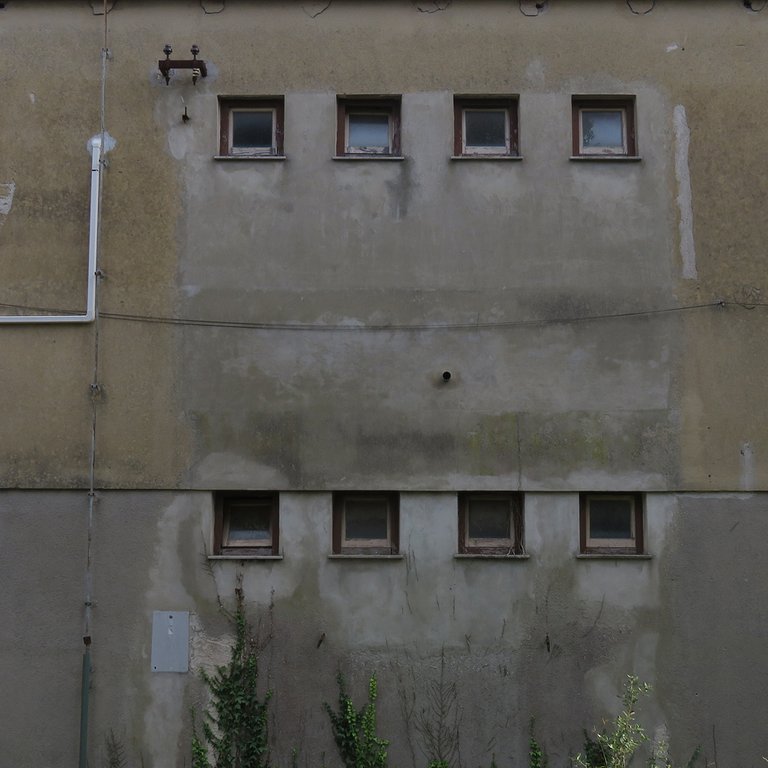
... so I took a couple of shots of the facade.

There is an official entrance, a gate with the abandoned guard booth not far from here, but I'll show you that at the end of the post, at the exit, because I entered quite unofficially, through the woods and passed by this pretty tall, solidly built transformer station.
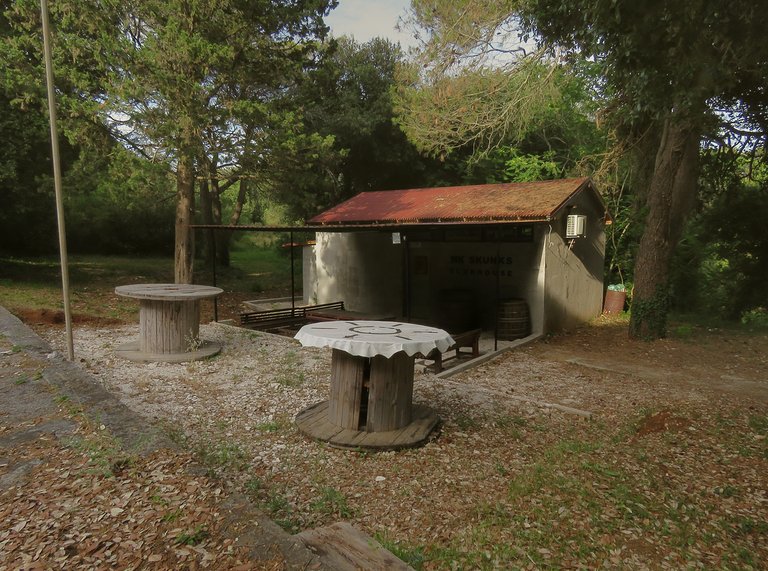
When I approached this small house ...

... I was surprised to see that it's a clubhouse ...

... of some local motorcycle club I didn't know existed.

Shishan's Hell Angels are called Skunks ...

... and they have a nice artwork on the entrance of their headquarters.

The club's terrace was also nice.

I photographed a friend there.

About twenty meters from the small clubhouse ...
... there is a large barbecue place for the gang ... or other groups of visitors ...

... it's always open and free to use. After this shot ...
... I took a last look at the transformer station ...

... and continued into the abandoned military zone.

I passed by some kind of makeshift picknick area ...

... and two lovely, blue mobile toilets ...

... and I arrived to a hangar surrounded by tall grass.

It was built in the early 50s, inspired by the American constructions of that period.

Many grasshoppers were jumping before my feet while I was walking around the hangar ...

... so I mounted the macro lens to take a couple of portraits here in the dry grass.
This is the Sphingonotus caerulans, and on the following photograph ...
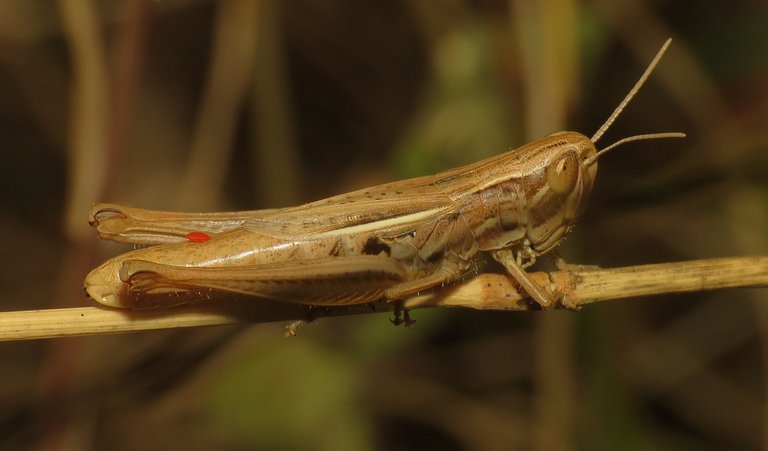
... you can see a pretty advanced, almost completely developed nymph of the
Euchorthippus declivus, a species commonly known as the Common straw grasshopper.

Not far from the hangar, just about thirty meters or so ...

... on the path that leads uphill, into the woods ...

... there is some kind of information board, bulletin board - something like that ...

... with interactive, rotating pictures and a bit of local history explained.

The works on the first, Austro-Hungarian fortification started in the 1915, during the World War One. Powerful canons were overlooking the sea route that leads from eastern Adriatic to the port of Pula, the important naval base not far from there.

After the 1918, with the imperial administration disbanded and gone from this area, the military structures were used first by Italy that got the control of Istra after the first war, by Germany during the World War Two occupation, and after that war, when the peninsula became part of the new socialist - wannabe communist Yugoslavia, Monte Maddona became a gargantuan, top secret project of the Cold War era. The most spectacular, kind of exaggerated stuff was built in that period, but I'll show you that part later, when we reach the top of the hill. Right now ...

... we are just a few steps from the information board, bulletin board, or however that thing is called ...

... near the first little bunker built by the Yugoslav army.

After the World War Two, when the place got under the control of the brand - new federal state of Yugoslavia, the military area was divided in two zones. Here you can see the shadow of the gate in between those areas, and on the following shot ...

... you can take a good look at the gate on a sunny, summer afternoon. The Zone number 2 that we just visited, with its military barracks, hangar and stuff, was partially hidden by the dense vegetation but still visible to the local population. But the Zone number 1, the hill Monte Madonna itself, was a well hidden secret for quite a few decades, from the early 50ies until 2002 when the passage to the hill was first opened.
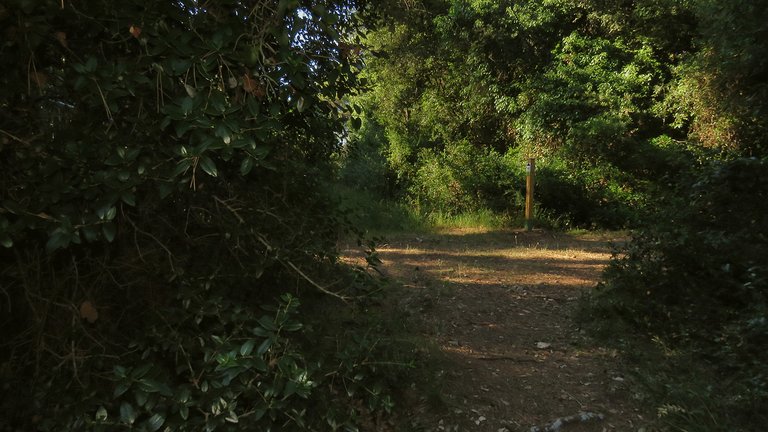
Even now, at first sight it looks like the visit must end here by the locked door, but there is a short and narrow path that leads around the gate, to the slightly larger path on the other side ...
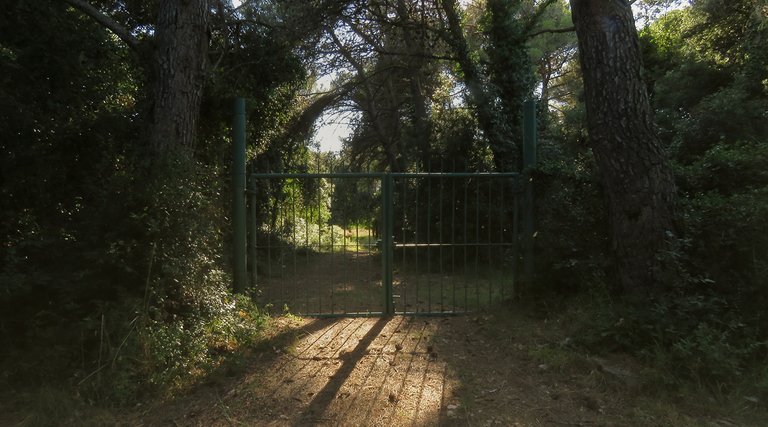
... so this tour can continue as we're leaving the gate behind.

About a hundred meters further, I encountered a little flash from the past, an old photograph showing the guards at the entrance of the Austro-Hungarian base in the summer of 1916. The first world war is still going on, the nearest front is in the Alps, where the empire is fighting with Italy. This place is quiet, but with the Europe gone crazy, you never know. The original photograph is kept in some museum in Slovenia, where the battles in that period were hard and bloody.
This image is a print on the info - sign along the road, a good place to take a little break and contemplate. After this shot ...

... I continued uphill ...

... surrounded by shrubs and trees.

After some more walking, I don't know how much exactly, maybe about fifty meters or so, I noticed a recently cleaned area that led to another, well hidden building, much larger than the usual bunkers.

I photographed this small black hole that leads to some deep, mysterious place excavated in the rocks along the clearance, and then ...

... after taking this shot at the decaying door ...

... I entered the large building. The lines on the ceiling looked like wooden beams at first ...

... but the thing was actually made of concrete and metal ...

... and small bats were resting upside down, well camouflaged on that rusted surfaces.

I built a little pedestal under the bats, using the stones and various garbage, and then climbed on that to get closer with my camera.
When I was satisfied with what I shot, I left the bats to rest in their quiet, half - dark atmosphere ...
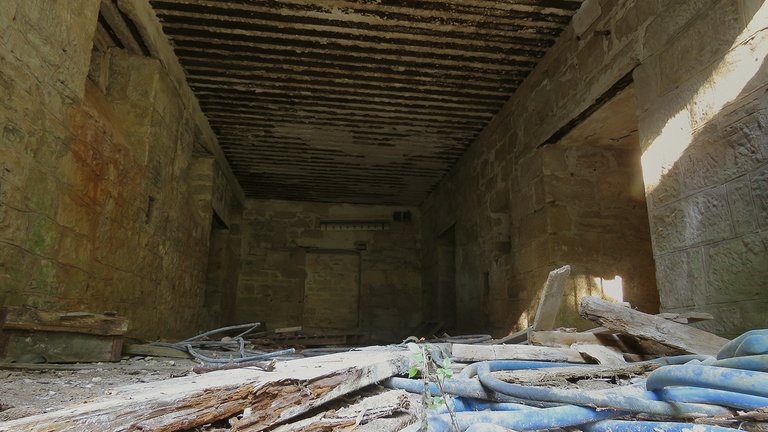
... and got out of that bunker - like hangar.

It was late afternoon, and the stag beetles (Lucanus cervus) were flying above me.

These pretty big beetles with interesting mandibles are getting active as the evening approaches. Only male have the cool mandibles.

I wasn't able to catch the beetles in flight, but one of them landed pretty clumsily on the branch of the tree, and soon ended up down in the grass, so I was able to take these shots.
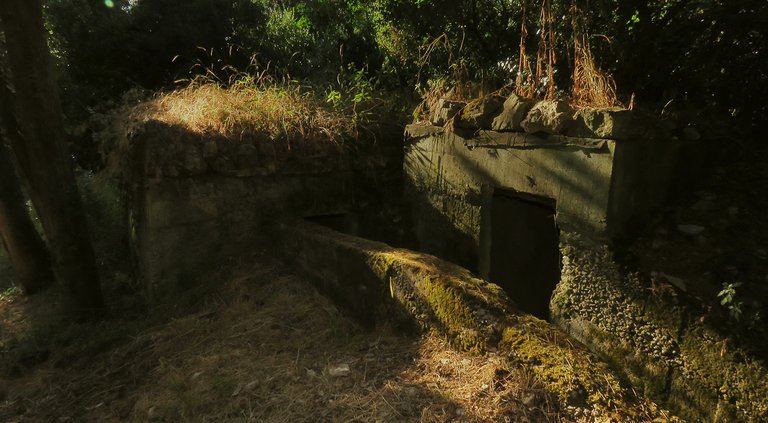
After some more walking ...

... I found a small bunker with very narrow entrance.

I took a look at the interior ...

... and in one upper corner ...

... I noticed a bat. It looked that just one bat is using this shelter, but when I came closer ...
... I saw that this is a female embracing the young cub ... or pup ... or however the baby bat is called. These are the Rhinolophus hipposideros, commonly known as the Lesser horseshoe bats. Today, while preparing this post, I learned that these bats mate in autumn, and then after hibernating during the winter, the females give birth to one pup, normally between mid-June and the beginning of July. These photographs were taken in between 6th and 9th of July.

Once outside the bunker, after some more walking, I arrived to another information board. This one had another old photograph on one side ...
... and on the other side was a collage made of some old maps and the portrait of Franz Joseph, the Emperor that died in 1916.

This old shot was taken on the top of Monte Madonna in 1914. The first world war has begun some months ago, or it's about to begin soon, a matter of months or days. The cannon is pretty impressive.

When I read everything on that board ...

... it was time to photograph the nearby concrete construction ... from above ...

... and down below.
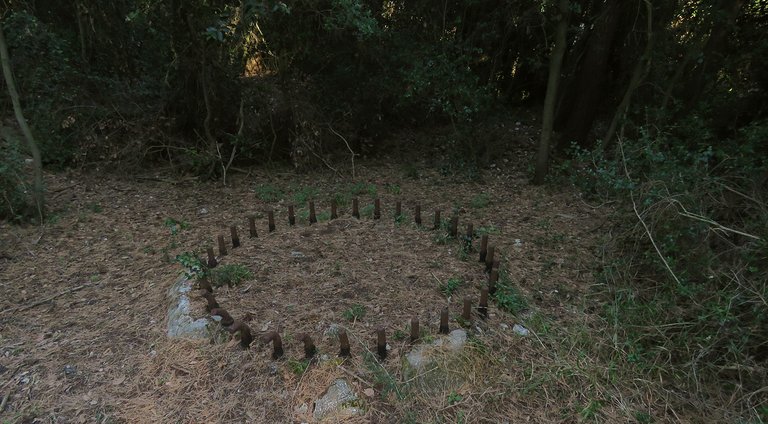
Not far from there, I saw what looked like some ritual place ... a magic circle ...

... that was holding a big weapon once.

On one of those big rusted screws, I found another interesting insect.

This is the Dorcus parallelipipedus, a smaller relative of the Lucanus cervus stag beetles. In this species, the males and females look more or less the same.
Just a bit further ...

... practically on the top of the hill ...

... I arrived at the small but heavy and thick armored door ...

... one of the entrances to the large underground complex excavated in the rock, a nuclear attack-proof fortress built from the early 50ies to the early 60ies, approximately. Since I couldn't enter ...

... I climbed higher, above the thing ...
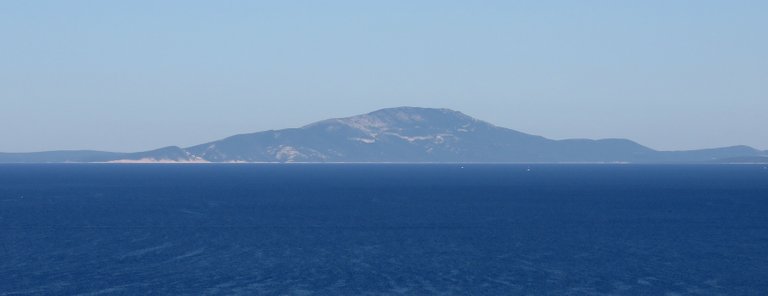
... to enjoy the view.

I photographed the big, distant island called Cres ( you can read it more or less like Tzres) in front of me ...

... and then I descended a bit and photographed this well hidden observation point of the underground base, just behind me.

I continued sniffing around the crest of the hill ...

... through the dense vegetation ...

... and when I reached this lookout structure that gave me an opportunity to take a good look above the dense foliage ...

... I saw a beautiful, very calming summer scene ...

... the blue sea and wild beaches with no tourism - related infrastructure.
People were enjoying the last hours of the long summer day ...

... and I was enjoying the shapes, colors and small details through the lens of the camera.

A small white boat was resting near the rocky shore ...

... I found a narrow inlet with a small harbor ...

... it looked like a blue river ...

... and further south, behind the vast open meadows, there was a lovely little lighthouse.
I spent some nice meditative time there, maybe about 15 minutes or so, and then ...

... I descended a bit.

On this side of the hill, you can see the places where the Cold War artillery was mounted ...

... massive concrete constructions that sprout from the stony terrain.
I came closer to see if there's some life in this desolate remains.
A small brigade of Crematogaster scutellaris ants was crawling across the circle that was once occupied by some big cannon ...
... that was the only army still active in this place.

I photographed many details, holes and entrances ...

... some recent graffiti ...
... found the Pholcus phalangioidesin some niche ...

... and spent a good half an hour around these constructions.

Today, while preparing this post, I learned that in the underground tunnels and rooms of the fortress, the temperature is always in between 12 and 15 degree Celsius.

The total length of the tunnels is about 500 meters, and most of the base is situated at the depth of 30 meters from the surface.
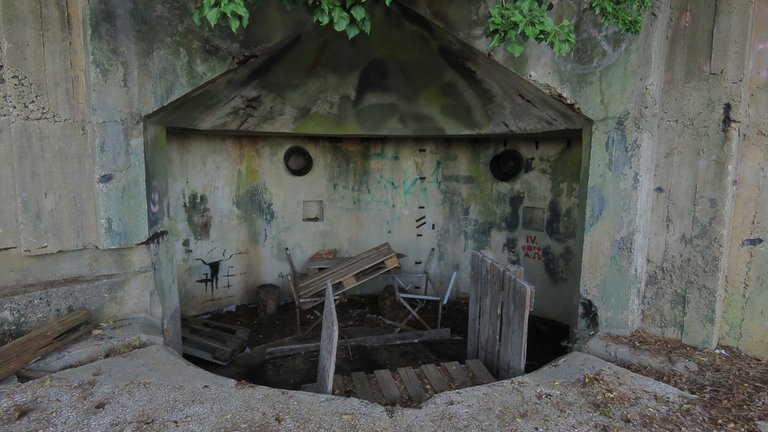
The thing was constructed with some pretty special, resilient concrete. Quartz was added to the mix for the greater resistance during the explosions.

After this shot, I continued exploring the area a bit downhill, on this side of the hill. The opposite of the side from which I came.

I noticed a rail on the stony ground ...

... and today I learned that a giant spotlight able to light up a good chunk of the bay down below was moving along this rail.

I followed the thing ...

... and arrived to another bunker.

I walked down the stairs ...

... entered the place ...
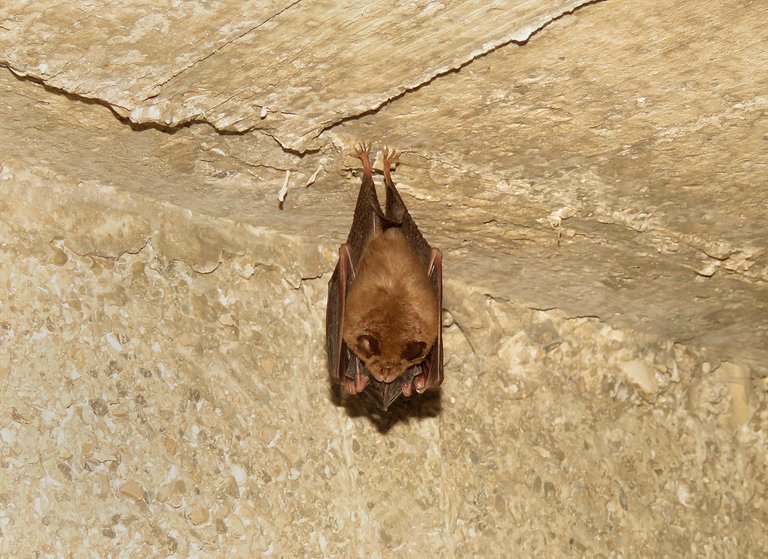
... and found another bat. After taking this photograph, I decided to go back. Back to the car, and then home.

The night wasn't very far, and I was pretty tired at this point.

Someone constructed a rusty robot made of various metal garbage ...

... and tied it to a pine tree near the path that passes by the massive concrete constructions. It looked like some old guardian from an ancient civilization destroyed in a final war that ended all wars ... and all others civilized stuff.

I had the sensation that Rusty (that's the name that the author gave him) could be activated at any moment. Like in the Fallout video game.

On the way back, as I was slowly walking downhill, surrounded by shrubs and trees ...

... the flies were flying in front of me, always keeping the safe distance. They looked like little stars in the evening light.

I passed by the empty guard post with no guard in sight ...
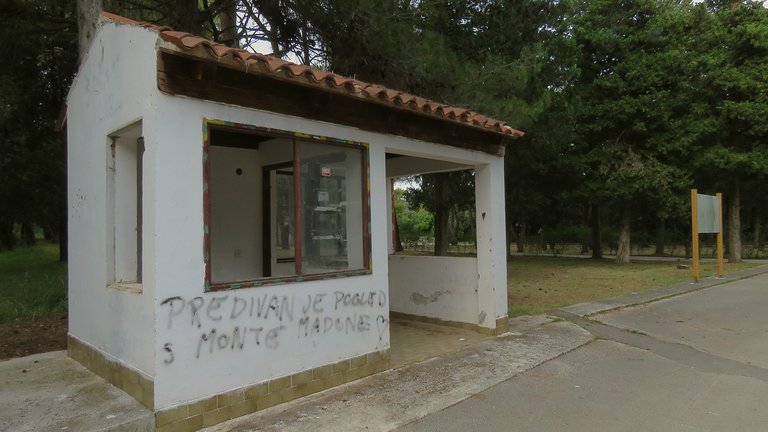
... and stepped out of the military area.

My car was parked near the small picknick area ...
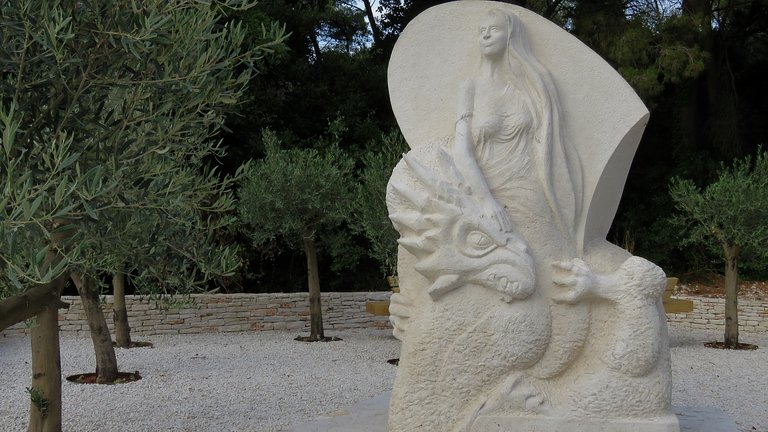
... with a petrified model and some kind of dragon in its center. The thing was recently finished ...

... so this road roller was still parked nearby.

After taking this final shot, I sat in my car and drove away.
As always here on HIVE, the photographs are my work - THE END.






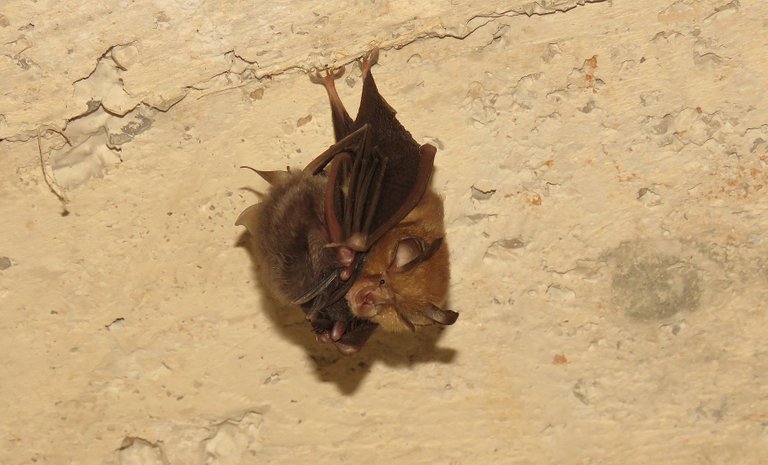








The history of the world. Who needs a book? There it is, the 20th century in sum. Right there in your backyard. And who inherits the ruins? Bats. Beetles. Spiders. So much for all the sound and fury.
This is a brilliant post (Yeah, I did major in history as an undergraduate so I was fascinated by your tour).
Thanks!!! :) Glad you like this mix of history, natural history and just rambling around :D
oh, my such a wonderful place with the ugly architecture and everything ugly as it can be ugly and this makes it even more wonderful for imagination and photography.
thank you :-)
:) True, a bit of decaying ugliness can be quite inspiring.
Do you think those huge bolts were bent when the artillery was removed, or as a result of the use of it?
Hm, I don't know. My first thought is that they were bent when the thing was dismantled ... but I'm far from being sure about that.
Gorgeous views! ... The grasshoppers look like they're wearing camouflage! They must be part of the army too, along with the ants.
Great observation about the military look of the grasshopper's markings and colors. :D
It is very beautiful to see the Shishan place. You have learned a lot through this post. The pictures have been very beautiful.
Congratulations, your post has been added to Pinmapple! 🎉🥳🍍
Did you know you have your own profile map?
And every post has their own map too!
Want to have your post on the map too?
That bat is super cute and kind of ugly at the same time.
True. :D A cute little monster,
With enormous teeth. I remember cleaning a gutter from leaves and found a tiny bat the size of my thumb that looked like a crumpled leaf until it turned its head at me.
:)